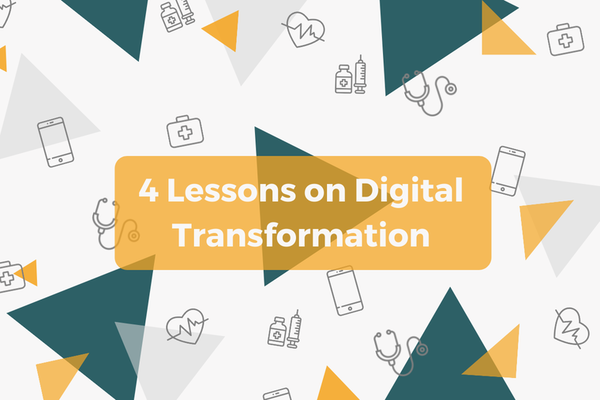
Most will agree when I say that last year was a whirlwind. We saw our “normal” become not-so-normal in a matter of a few days.
Our team worked tirelessly with clients to get digital products to market that were, at that point, needed yesterday. In a way, COVID-19 lit a fire under many healthcare organizations and helped us all realize how quickly we could spin up new essential, customer-facing products.
Today, we’re taking a step back from last year to give you an update of what’s going on in healthcare.
Below are 4 critical lessons we’ve learned in the past year about where large providers are today with respect to digital transformation.
As an industry, healthcare has historically been slower to adopt digital when compared to comparable industries like financial services or automotive. However, over the past couple of years, we’ve seen an increasing number of healthcare organizations actively seek digital transformation and invest in discrete digital capabilities.
Surely, investing in digital is a crucial competitive advantage considering Accenture’s recent report, How COVID-19 Will Permanently Alter Patient Behavior, that shares 60% of patients want to use technology more for communicating with healthcare providers and managing their conditions.
And, according to a Business Group on Health Survey, 80% of employers think virtual care will have a big impact on how people get care moving forward (up from 50% in 2018), with 53% of large employers saying that implementing more virtual care solutions is their top initiative for 2021.
**Free tip: If your organization hasn’t invested in mobile engagement, but is considering it, you might value this webinar recording. In it, Ballad Health shares how they built an EHR-integrated, patient-facing mobile application that delivers an all-in-one experience to customers.
Recent research shows that health care providers have made a lot of progress in discrete digital capabilities —implementing ratings and reviews, launching mobile applications, standing up online billing, and more — but have done very little to truly connect all digital features into a cohesive customer experience.
Although we see digital taking off, much of this work in healthcare organizations is siloed and therefore creates pain points for the end consumer. If healthcare providers are going to win more customers in today’s digital landscape, they will need to stop seeing digital as a collection of features, and start seeing it as the way to build a better and more connected customer experience.
Over the past couple of years, we’ve seen an increased rate of willingness to use digital tools and mobile apps to manage healthcare conditions.
44% of patients used new devices or apps to help manage conditions remotely during COVID-19 and 70% expect that the use of technology will be more prominent in their lives over the next 3 years.
While we believe it is still early in the adoption curve, many healthcare systems are choosing to take control of their mobile patient experience by building a branded, proprietary mobile application that directly integrates with their EHR.
Whatever your path, having a focused mobile customer engagement strategy will be critical for health systems looking to better serve the growing mobile native population.
Journey mapping is an activity that purposefully helps organizations better understand their customers needs, pain points, and overall how the end customer interacts with the organization’s digital tools and brand.
We recently surveyed 11 nationally ranked children’s hospitals to better understand their progress on achieving digital transformation. When we asked about customer journey mapping, only 2 out of the 11 indicated that they had completed full, cross-functional customer journey maps that were being used across the organization.
“Customers experience roadblocks, dead ends and frustration in their journey. The more friction we put in front of potential customers, the less likely they are to complete the journey.” – Forbes
Why spend hundreds of thousands of dollars on a consumer-facing product that does not at all meet the needs of the customer? Not only can journey mapping help you strategically set goals and expectations, but you can also truly understand what your customers need.
**Free tip: Do you know the very basics of how your patients engage with you on the web? This guide is full of questions, exercises, free tools, and more! Download our free guide today to make the most out of your web analytics platform and learn how your website stacks up against our clients.
We help healthcare organizations identify the right digital strategies and create products that infuse control, transparency, and choice into the consumer healthcare experience.
In today’s ever-evolving healthcare landscape, data analytics has become an indispensable tool for driving improvements in patient care, operational efficiency, and cost management. ...read more
Your hospital or health system’s web analytics tell a story.It’s a story about how healthcare consumers are using your website, and it’s told in milliseconds, minutes, ...read more
The state of the U.S. healthcare system and the increased demand placed on employees are contributing to a high number of health workers experiencing burnout and leaving ...read more
Earlier this month, our team sponsored, exhibited, and presented at the Healthcare Marketing & Physician Strategies Summit in Miami. It was refreshing to be back in person and ...read more

Connect Patients to Care Faster With HIPAA-Compliant Maps
A Feature Rich Alternative to Google Maps